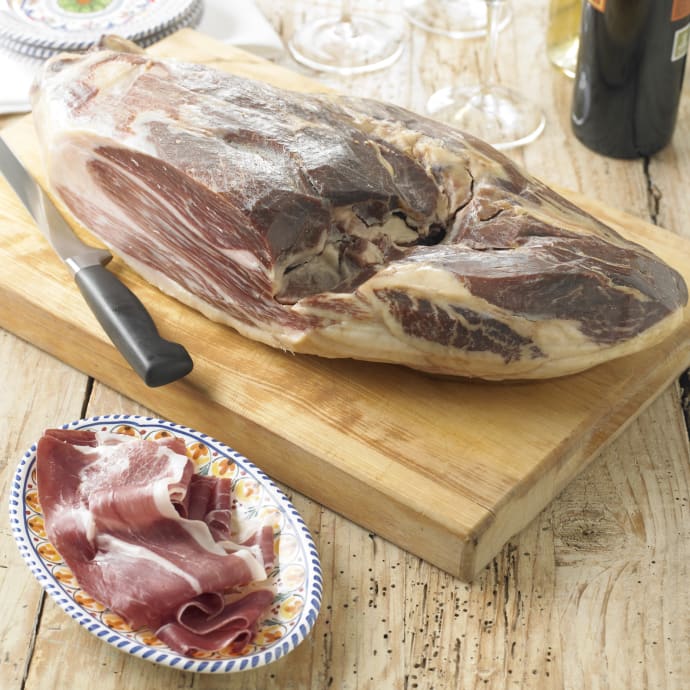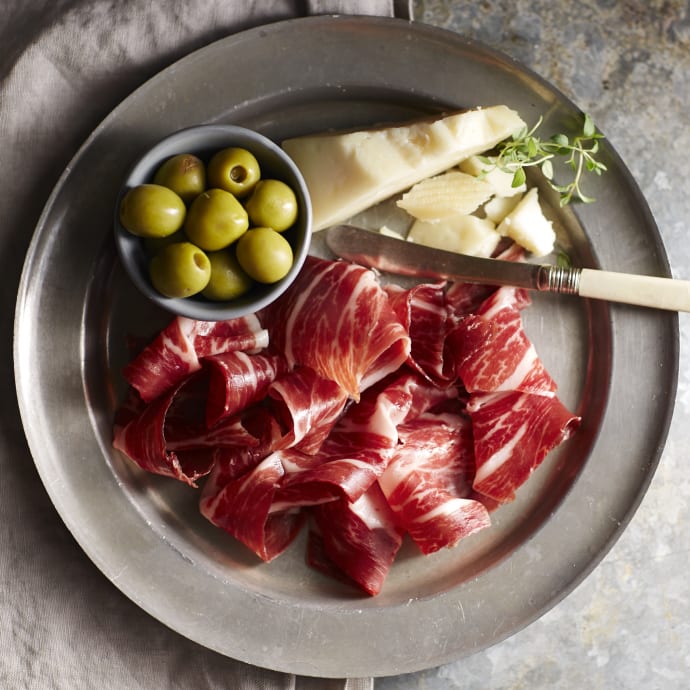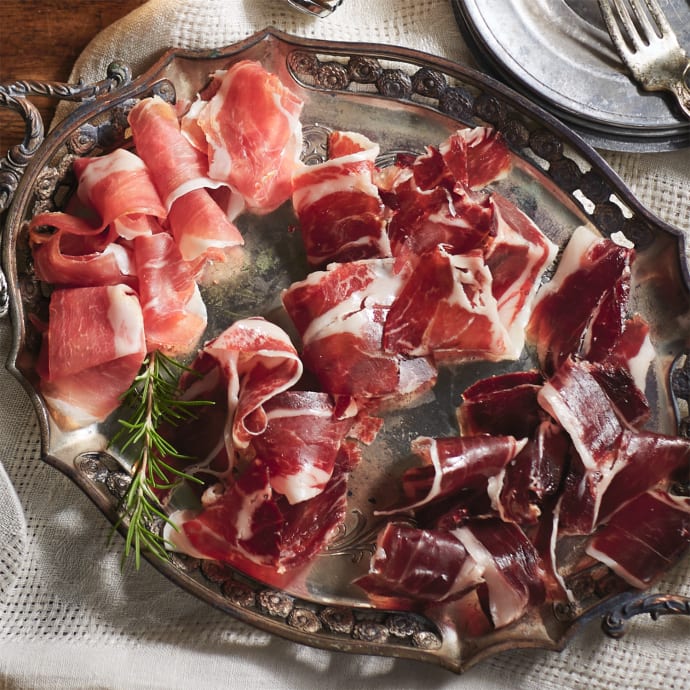Order by 12/23 for Delivery by Christmas! Shop Gift Guide

Explorer
The New York Times
-
November 6, 2004
Castles, Caves and Prized Pigs in Southern Spain
Christopher Clarey
My first contact with the Sierra de Aracena came in a tapas bar in Seville, more than an hour's drive from the region. Casa Roman was and remains a cacophonous, atmospheric place full of smoke-streaked oil paintings and wooden stools; of neatly dressed, slick-haired locals; and of tourists trying their best to keep their guidebooks tucked out of sight.
Casa Roman became my family's neighborhood watering hole during the many years we lived in Seville's labyrinth of an old city. Yet the bar was renowned not for its ambience, but for its ham. And it is where, in 1996, I first tasted the Spanish acorn-fed variety, jamón ibérico de bellota, that comes from the Sierra de Aracena, the hill country northwest of Seville.
The Spanish have long considered it the world's finest ham, and the world is increasingly in agreement, even though it remains, at least for another year or two, impossible to buy it in the United States.
At Casa Roman, as in many Spanish restaurants, the hams dangle like stalactites from the rafters. As you snuggle up to the bar and reach for your glass of Cruzcampo beer or Fino Quinta sherry, you find your nose only a few inches from the moist, mold-streaked piece of cured meat that is still sweating just enough to require the appendage of a small white cup to trap the occasional drop of golden fat that oozes down its sides at a leisurely, Andalusian pace.
"Our good customers like to say, 'Serve me a ham that cries,' " said Rafael Escobar, a 65-year-old Sevillano who began working behind the bar at Casa Roman in 1983.
Up so close, the smell is vaguely sweet, vaguely musty. But once the ham has been carefully, artfully sliced into thin, dark red, nearly translucent rectangles and placed before you with requisite pride on a plain white plate, the taste is anything but vague: It is an unctuous blend of tender, nutty flesh and savory fat that does not quite melt in your mouth, which is for the best considering that you are in no hurry for it to go away.
Unlike some of the other best things in life, jamón de bellota was not an acquired taste. It was something to relish from the start, even for my two very young daughters, who would devour it by the plateful at no small expense considering that a plateful often costs 15 euros ($18.50) or more. As the weeks turned into months and then years, my family and I began making regular pilgrimages to the region where these remarkable hams were produced.
The Sierra de Aracena has long been a popular weekend retreat for Sevillanos, and it is a place of subtle charm rather than lunge-for- your-camera splendor: much more the Berkshires than the Grand Tetons. None of its peaks exceed 3,000 feet. Its rustic, whitewashed villages are not as postcard-ready as the artfully tended hill towns of Tuscany or the spectacularly situated white towns like Ronda that lie to the southeast of Seville. If you are looking for a week of elaborate, high-end cuisine, you're much better off heading to the rolling countryside of Burgundy or Catalonia.
But there is a roughhewn authenticity in the stone walls, wooded pastureland, medieval castles and unpretentious bars and restaurants of the Sierra de Aracena. It is an area best visited in spring or autumn - the winters are clammy and the summers hot - and when we returned in April for three days of hiking, exploring and eating, it was, as always, not quite enough.
The best-known town is Jabugo, famous because it is the center of the ham industry. The sound of its name is enough to make most Spaniards start scouting for a place to have lunch, but aficionados know that Jabugo is not the only town in this region that produces top-quality ham. Producers like Lazo in Cortegana and Chacón in Cumbres Mayores also have excellent reputations. And, from a scenic perspective, Jabugo, with its scruffy outskirts and inelegant mix of old and modern facades, is hardly the highlight of a region that extends from the clifftop town of Zufre in the east to Aroche in the west, close to the Portuguese border.
The area, part of a protected region that regulates further development, is at its most appealing on the meandering two-lane road of uneven quality that leads from the town of Aracena to Cortegana through rolling, wooded scenery, passing through the hamlets of Linares de la Sierra, Alájar and our family's favorite, Almonaster la Real.
Almonaster's exclamation point is its small jewel of a mezquita, or Moorish mosque, with an attached bullring. The mezquita dates from the 10th century and is the only significant Islamic building in the Sierra. The mosque, with its red brick arcades, is rarely used for worship, and the bulls are fought next door just once a year in mid- August. But the view from the mezquita's steps at sunset - with the undulating green hills changing tones before you - is there in all seasons, and it is one of the finest in these mountains.
It has competition, however, including the more exposed, panoramic view from atop the battlements in Cortegana's well-restored castle, which was part of the defenses built throughout the region in the late 13th and 14th centuries after the reconquest of this part of Spain from the Moors.
A more isolated fortress across the border in Portugal is a scenic detour: north of Aroche to Barrancos and then along a lonely seven- mile dirt track to the castle of Noudar, a birdwatcher's delight that sits high above a big bend in the Ardila River. From Aroche, reaching Noudar takes about an hour, and you can drive to the castle or stop and park when it comes into view and hike the other mile or three. We
hiked, which was good for the constitution but not for the reward. We just missed closing time at 5 p.m. and had to peek through slits in the gate to glimpse the resident sheep, goats and guard dogs of this fortified medieval village that was home to 300 people and is now home to a caretaker and his livestock.
Back on the much more beaten track in Aracena the following day, we arrived in time to revisit one of Europe's most remarkable caves - the Gruta de las Maravillas - whose entrance point is not in a remote valley but in the middle of town. Open to visitors since 1914, it has long been the primary tourist magnet in the region, and the cobblestoned path that leads to the entrance is lined with souvenir shops, ham emporiums and restaurants, although the better restaurants are found elsewhere in this pleasant, attractive town of about 7,000.
The remnants of the city's Moorish castle loom overhead, but what is below is more spectacular: more than a mile of mineral formations, crystalline pools and chambers with apt names like the Cathedral. In nearly a century of human impact and less-than-optimal lighting have damaged the cave's integrity, generating algae and lichen growth on some of its features, it is worth the walk and the often cramped
quarters.
But the destination should not be the absolute priority in the Sierra de Aracena, which is best treated not as a checklist but as a wandering zone. It is a place to follow the small footpaths that link villages; a place to catch a glimpse of that monastery perched high above the road and try to find a way to reach it; a place to walk into a noisy, humble local restaurant full of families whose children keep migrating from the table to the street and to order a glass of sherry or red wine from Rioja to go with some dish, any dish that comes from the local pigs.
You see the pigs frequently as you travel here, and they hardly resemble the lumbering pink variety that produce fillings for American sandwiches. Iberian pigs are smaller, darker and hairier, with comparatively long and slender legs. They are the descendants of wild boars, although they scatter in a hurry if you make a brusque movement. Their color is where the term pata negra (black leg) originates, and breeders of pata negra maintain that what really separates their pigs from the rest of the world's herd is their unusual metabolism, which allows fat to permeate into their muscles, giving the meat the sort of marbled quality that Texas ranchers appreciate.
The pigs' active lives help in that process. In late October, they are sent into the dehesa - the wooded pastures of Andalusia - for the montanera, where amidst the holm oaks and cork oaks that cover the Aracena region, they stuff themselves on grass and acorns during the fattening process before the slaughter. It has been estimated that each pig will eat 1,000 pounds of acorns or more during the next
three months.
After the slaughter, which in Spanish translates as "the sacrifice," they are packed in sea salt for one day for each kilogram (2.2 pounds) of weight and then kept in two types of storage rooms to sweat. From cradle to grave to tapas bar, the process takes at least two years, and though the clientele remains largely Spanish, that is beginning to change.
Top French chefs like Alain Ducasse have also become converts, and several restaurants in Paris now specialize in "Jabugo." There is increasing demand in Japan, and though true jamón ibérico has long been banned in the United States because no Spanish slaughterhouse or curing facilility met United States Department of Agriculture standards, that changed in July when a small producer in northern Spain became the first to receive a permit to export to the United States. Some producers from Aracena are also seeking permits, and one American online store, La Tienda in Williamsburg, Va., is taking preorders on Iberian hams for 2007 or 2008 (estimated price is $800 to $1,000 per ham).
Nonetheless, enjoying the best that the Sierra de Aracena has to offer in the United States won't have the same subtle appeal (or price tag) as enjoying it in the Sierra de Aracena, where the mood and the crowds remain agreeably light, and where the black pigs meet their makers after a long, sweet feed under the oak trees.
Christopher Clarey
My first contact with the Sierra de Aracena came in a tapas bar in Seville, more than an hour's drive from the region. Casa Roman was and remains a cacophonous, atmospheric place full of smoke-streaked oil paintings and wooden stools; of neatly dressed, slick-haired locals; and of tourists trying their best to keep their guidebooks tucked out of sight.
Casa Roman became my family's neighborhood watering hole during the many years we lived in Seville's labyrinth of an old city. Yet the bar was renowned not for its ambience, but for its ham. And it is where, in 1996, I first tasted the Spanish acorn-fed variety, jamón ibérico de bellota, that comes from the Sierra de Aracena, the hill country northwest of Seville.
The Spanish have long considered it the world's finest ham, and the world is increasingly in agreement, even though it remains, at least for another year or two, impossible to buy it in the United States.
At Casa Roman, as in many Spanish restaurants, the hams dangle like stalactites from the rafters. As you snuggle up to the bar and reach for your glass of Cruzcampo beer or Fino Quinta sherry, you find your nose only a few inches from the moist, mold-streaked piece of cured meat that is still sweating just enough to require the appendage of a small white cup to trap the occasional drop of golden fat that oozes down its sides at a leisurely, Andalusian pace.
"Our good customers like to say, 'Serve me a ham that cries,' " said Rafael Escobar, a 65-year-old Sevillano who began working behind the bar at Casa Roman in 1983.
Up so close, the smell is vaguely sweet, vaguely musty. But once the ham has been carefully, artfully sliced into thin, dark red, nearly translucent rectangles and placed before you with requisite pride on a plain white plate, the taste is anything but vague: It is an unctuous blend of tender, nutty flesh and savory fat that does not quite melt in your mouth, which is for the best considering that you are in no hurry for it to go away.
Unlike some of the other best things in life, jamón de bellota was not an acquired taste. It was something to relish from the start, even for my two very young daughters, who would devour it by the plateful at no small expense considering that a plateful often costs 15 euros ($18.50) or more. As the weeks turned into months and then years, my family and I began making regular pilgrimages to the region where these remarkable hams were produced.
The Sierra de Aracena has long been a popular weekend retreat for Sevillanos, and it is a place of subtle charm rather than lunge-for- your-camera splendor: much more the Berkshires than the Grand Tetons. None of its peaks exceed 3,000 feet. Its rustic, whitewashed villages are not as postcard-ready as the artfully tended hill towns of Tuscany or the spectacularly situated white towns like Ronda that lie to the southeast of Seville. If you are looking for a week of elaborate, high-end cuisine, you're much better off heading to the rolling countryside of Burgundy or Catalonia.
But there is a roughhewn authenticity in the stone walls, wooded pastureland, medieval castles and unpretentious bars and restaurants of the Sierra de Aracena. It is an area best visited in spring or autumn - the winters are clammy and the summers hot - and when we returned in April for three days of hiking, exploring and eating, it was, as always, not quite enough.
The best-known town is Jabugo, famous because it is the center of the ham industry. The sound of its name is enough to make most Spaniards start scouting for a place to have lunch, but aficionados know that Jabugo is not the only town in this region that produces top-quality ham. Producers like Lazo in Cortegana and Chacón in Cumbres Mayores also have excellent reputations. And, from a scenic perspective, Jabugo, with its scruffy outskirts and inelegant mix of old and modern facades, is hardly the highlight of a region that extends from the clifftop town of Zufre in the east to Aroche in the west, close to the Portuguese border.
The area, part of a protected region that regulates further development, is at its most appealing on the meandering two-lane road of uneven quality that leads from the town of Aracena to Cortegana through rolling, wooded scenery, passing through the hamlets of Linares de la Sierra, Alájar and our family's favorite, Almonaster la Real.
Almonaster's exclamation point is its small jewel of a mezquita, or Moorish mosque, with an attached bullring. The mezquita dates from the 10th century and is the only significant Islamic building in the Sierra. The mosque, with its red brick arcades, is rarely used for worship, and the bulls are fought next door just once a year in mid- August. But the view from the mezquita's steps at sunset - with the undulating green hills changing tones before you - is there in all seasons, and it is one of the finest in these mountains.
It has competition, however, including the more exposed, panoramic view from atop the battlements in Cortegana's well-restored castle, which was part of the defenses built throughout the region in the late 13th and 14th centuries after the reconquest of this part of Spain from the Moors.
A more isolated fortress across the border in Portugal is a scenic detour: north of Aroche to Barrancos and then along a lonely seven- mile dirt track to the castle of Noudar, a birdwatcher's delight that sits high above a big bend in the Ardila River. From Aroche, reaching Noudar takes about an hour, and you can drive to the castle or stop and park when it comes into view and hike the other mile or three. We
hiked, which was good for the constitution but not for the reward. We just missed closing time at 5 p.m. and had to peek through slits in the gate to glimpse the resident sheep, goats and guard dogs of this fortified medieval village that was home to 300 people and is now home to a caretaker and his livestock.
Back on the much more beaten track in Aracena the following day, we arrived in time to revisit one of Europe's most remarkable caves - the Gruta de las Maravillas - whose entrance point is not in a remote valley but in the middle of town. Open to visitors since 1914, it has long been the primary tourist magnet in the region, and the cobblestoned path that leads to the entrance is lined with souvenir shops, ham emporiums and restaurants, although the better restaurants are found elsewhere in this pleasant, attractive town of about 7,000.
The remnants of the city's Moorish castle loom overhead, but what is below is more spectacular: more than a mile of mineral formations, crystalline pools and chambers with apt names like the Cathedral. In nearly a century of human impact and less-than-optimal lighting have damaged the cave's integrity, generating algae and lichen growth on some of its features, it is worth the walk and the often cramped
quarters.
But the destination should not be the absolute priority in the Sierra de Aracena, which is best treated not as a checklist but as a wandering zone. It is a place to follow the small footpaths that link villages; a place to catch a glimpse of that monastery perched high above the road and try to find a way to reach it; a place to walk into a noisy, humble local restaurant full of families whose children keep migrating from the table to the street and to order a glass of sherry or red wine from Rioja to go with some dish, any dish that comes from the local pigs.
You see the pigs frequently as you travel here, and they hardly resemble the lumbering pink variety that produce fillings for American sandwiches. Iberian pigs are smaller, darker and hairier, with comparatively long and slender legs. They are the descendants of wild boars, although they scatter in a hurry if you make a brusque movement. Their color is where the term pata negra (black leg) originates, and breeders of pata negra maintain that what really separates their pigs from the rest of the world's herd is their unusual metabolism, which allows fat to permeate into their muscles, giving the meat the sort of marbled quality that Texas ranchers appreciate.
The pigs' active lives help in that process. In late October, they are sent into the dehesa - the wooded pastures of Andalusia - for the montanera, where amidst the holm oaks and cork oaks that cover the Aracena region, they stuff themselves on grass and acorns during the fattening process before the slaughter. It has been estimated that each pig will eat 1,000 pounds of acorns or more during the next
three months.
After the slaughter, which in Spanish translates as "the sacrifice," they are packed in sea salt for one day for each kilogram (2.2 pounds) of weight and then kept in two types of storage rooms to sweat. From cradle to grave to tapas bar, the process takes at least two years, and though the clientele remains largely Spanish, that is beginning to change.
Top French chefs like Alain Ducasse have also become converts, and several restaurants in Paris now specialize in "Jabugo." There is increasing demand in Japan, and though true jamón ibérico has long been banned in the United States because no Spanish slaughterhouse or curing facilility met United States Department of Agriculture standards, that changed in July when a small producer in northern Spain became the first to receive a permit to export to the United States. Some producers from Aracena are also seeking permits, and one American online store, La Tienda in Williamsburg, Va., is taking preorders on Iberian hams for 2007 or 2008 (estimated price is $800 to $1,000 per ham).
Nonetheless, enjoying the best that the Sierra de Aracena has to offer in the United States won't have the same subtle appeal (or price tag) as enjoying it in the Sierra de Aracena, where the mood and the crowds remain agreeably light, and where the black pigs meet their makers after a long, sweet feed under the oak trees.
Other Press
The Winter Travel Shortlist: Problem-Solving Essentials I’m Packing This Season
Forbes
-
November 20, 2025
54 Gifts for People Who Have Everything
Wirecutter
-
November 6, 2025
What Andrew Zimmern Can’t Live Without
The Strategist
-
June 30, 2025
8 Tasty Ways To Travel The World With Food
Forbes
-
June 17, 2025
Featured Products
 SHIPS FREE
SHIPS FREECinco Jotas Bone-In 100% Ibérico de Bellota Jamón - FREE SHIPPING!
JM-106
(4)
$1,599.00$1,599.00
 SHIPS FREE
SHIPS FREEBone-In Jamón Ibérico Ham by Fermín - FREE SHIPPING!
JM-11
(9)
$799.00$799.00
 SHIPS FREE
SHIPS FREEBoneless Jamón Ibérico Ham by Fermín - FREE SHIPPING!
JM-12
$799.00$799.00
 BEST SELLER
BEST SELLERSliced Ibérico de Bellota Ham by Peregrino, Nitrate Free - 2 oz
JM-52
(47)
$42.00$42.00
 BEST SELLER
BEST SELLERSliced Ibérico Ham by Peregrino, Nitrate Free - 2 oz
JM-23
(38)
$28.00$28.00
 BEST SELLER
BEST SELLERJamón Tasting Trio of Sliced Ham
JM-25
(36)
$85.00$85.00
 BEST SELLER
BEST SELLERCured Meats of Spain Sampler
JM-45
(39)
$109.00$109.00







